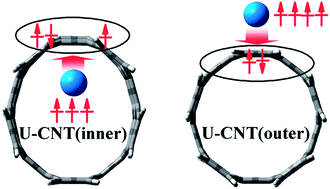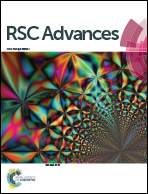Carbon nanotubes adsorb U atoms differently in their inner and outer surfaces†
Abstract
Effective clean up of radioactive waste remains one of the fundamental challenges in nuclear sciences due to the ever growing concern on the safety of nuclear power. Carbon nanotubes have recently shown encouraging promise in their potential capability of U atom adsorption and removal. In this paper, we used first-principles density functional theory (DFT) to illustrate the adsorption and interactions between U atoms and the inner/outer surfaces of a single-walled carbon nanotube. Our DFT calculations showed that when U atoms were adsorbed on each of the CNT surfaces, the ground electronic states were all quintet. However, U atoms showed differential adsorption modes depending on the surface, binding to bridge sites on the inner surface, and to hole sites on the outer surface. The interior adsorption was more stable with an interaction energy of about 1 eV greater than that of the external one, which is explained by their different ground state electronic structures. The electronic states were largely influenced by the ferromagnetic coupling between the U atoms and the net spintronics of the CNT only for the internal adsorption case, with the external adsorption mainly determined by the U atoms. Orbital and charge analysis show that compared to the external adsorption, there were about 1.0e more charge transfers between the internally adsorbed U atom and the CNT, which facilitated stronger donor–acceptor interactions. Further analysis on the density of states indicated that the internal adsorption had a larger bonding area between the U atoms and CNT, supporting the stronger internal adsorption.


 Please wait while we load your content...
Please wait while we load your content...